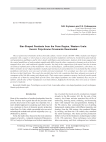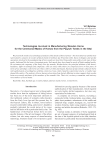Archaeology, Ethnology & Anthropology of Eurasia @journal-aeae-en
Статьи журнала - Archaeology, Ethnology & Anthropology of Eurasia
Все статьи: 524

Spatial Distribution of Finds on the Eastern Outskirts of Poltse I, the Amur Region
Статья научная
On the occasion of the 60th anniversary of the first excavations at Poltse I The study addresses the spatial arrangement of features at Poltse I—a Poltse culture settlement near the village of Kukelevo. An analysis of past scholarship reveals the sources of the modern understanding of the geographic and topographic location of the site and of its present condition. Although Poltse I and Poltse II, which is located nearby, were damaged by plowing in 1968, it is possible to continue excavations and obtain new information. On the basis of published materials, field plans in the archives, and artifacts at the SB RAS Institute of Archaeology and Ethnography, the first complete plan of excavations at Poltse I has been prepared, showing the arrangement of dwellings. Certain features of their design are described. Ceramic vessels found in each of the ten dwellings are listed. The vessels were placed along the perimeter of the interior, leaving free space around the central hearth and a passage to the exit. Most were concentrated in six dwellings. Only a few of them were used in everyday life, while most could have been destined for trade and barter. The abundance of ceramics (965 specimens and numerous separate fragments) makes Poltse I a key source for information on pottery manufacture, subsistence, and cultural ties. So far, it is impossible to say whether the vessels were manufactured in situ or imported.
Бесплатно

Spatial structures of the initial/early Upper Paleolithic at Tolbor-21, Northern Mongolia
Статья научная
This article describes the spatial structures of archaeological horizon 4 at Tolbor-21 in northern Mongolia, on the basis of data from 2015–2017. The presence of non-utilitarian items, faunal remains with traces of human impact, and the use of fi re render this site near outcrops of raw materials promising for the reconstruction of the spatial organization of Early Upper Paleolithic sites in northern Mongolia. Spatial analysis included visual observations and statistical procedures (clustering with two algorithms) aimed at identifying patterns in the distribution of fi nds in various areas. The infl uence of natural processes on the distribution of artifacts was evaluated with fabric analysis based on the positions of the long axes of fi nds. As a result, it was found that solifl uction variously affected the archaeological horizon in different parts of the slope. The effect was strongest in excavation 2, where two possibly overlapping episodes of fi rerelated activity have been reconstructed. Nevertheless, it is possible to separate two complexes differing in terms of fi nds, including signifi cantly modifi ed tools and bones with traces of human impact (“fi replace 1”) and a concentration of small artifacts (“fi replace 2”). In the upper part of the slope (excavation 4), near the stone structure, an accumulation of cores at the advanced reduction stages is reconstructed, as well as an area where ungulate carcasses were butchered. An area associated with primary reduction has been separated in excavation 1. The differential use of the camp area by its inhabitants seems to be an important feature of the subsistence strategy of the population of northern Mongolia during the initial stages of the Upper Paleolithic.
Бесплатно

Stages in the late Pleistocene and Holocene peopling of lake Bolshoye Ushkovskoye shore, Kamchatka
Статья обзорная
Бесплатно

Star-shaped pendants from the Perm region, Western Urals: Hunnic polychrome ornaments reanimated
Статья
Бесплатно

Stoilo—A Paleolithic Site in the Southern Angara Region, Siberia
Статья научная
On the basis of findings of the autumn 2021 field season, we present the first information on the Paleolithic site of Stoilo (Usolsky District of the Irkutsk Region). The site, located on the left bank of the Angara River, belongs to the Belaya geoarchaeological region. The complex is enclosed in pre-Holocene sediments relating to the residual gruspebble crust, which overlies the soliflucion layer tentatively dating to the Late Karga–Early Sartan period. The analysis of the lithics, mostly made on siliceous rocks, indicates prismatic reduction resulting in small blades. The toolkit consists of small pieces, including various types of spurred tools, burins, knives on naturally backed blades, retouched blades and flakes with use-wear, and a heavy-duty pebble tool. A specific feature of the complex is that most artifacts reveal superficial traces of minor corrasion—a weak surface gloss. This and the fact that the material relates to the gruspebble layer might be viewed as formal indicators of the “Makarovo Horizon”. However, the totality of typological and technological features and the structure of the sediments suggest that Stoilo represents the middle stage of the Upper Paleolithic, dating to the Early Sartan stage. To confirm this assumption, further excavations are needed in order to augment the collection and obtain more environmental data.
Бесплатно

Stone Age Ivory Points from the Arctic Zone of Northeast Asia
Статья научная
We give a technological and typological description of two well-preserved points (one fragmented rod-shaped, the other double-slotted), made of mammoth ivory and found in the Ust-Yansky District of Sakha-Yakutia in 2016. Traces evidencing various stages of manufacture are described in detail. A succession of technological operations is reconstructed, from the preparation of preforms and further processing by planing and abrasion to final polishing. Spall negatives on artifacts are interpreted as post-depositional damage that could have occurred from the effect of cryogenic processes in sediments. The slotted specimen is decorated with five finely engraved arrows. The discovery context and the morphology of the rod-shaped specimen are similar to those of ivory points from the Yana sites, whereas the slotted one resembles those from Zhokhovo and other Northeast Asian sites of the same age. Radiocarbon analysis of the points supports these findings. The following conclusions are reached: the rod-shaped point dates to MIS 3, and the slotted one, to MIS 2; such points evidence an elaborate technology of ivory processing during the Late Pleistocene and Early Holocene in the high latitudes of Northeast Asia and an adaptation to the scarcity of lithic raw material in the region.
Бесплатно

Stone Tools from an Island in Berd Bay, Novosibirsk Reservoir
Статья научная
This article presents the results of a multidisciplinary study of stone tools (discoid mace-head, adze, and axe) found on an island in Berd Bay, Novosibirsk Reservoir. Trace analysis suggests that the mace-head is made of fragile sandstone, precluding its use as a striking weapon. Therefore, it was likely a ceremonial weapon. The adze and the axe are also made of a local rock—shale. The specimens resemble prestigious weapons of the Early and Middle Bronze Age from the forest-steppe zone of southwestern Siberia. Discoid mace-heads, like globular ones, are typical of the Middle Bronze Age. Importantly, all the specimens were found where the submerged Fort Berdsk was possibly situated. Early artifacts have also been found near other Siberian forts such as Tomsk, Umrevinsky, and Sayansk, suggesting that these were built at places with a long history of habitation.
Бесплатно

Substitute offering: an Ob Ugrian ritual tradition surviving in the 20th and early 21st century
Статья обзорная
Бесплатно

Tagar artifacts at the Stavropol state museum reserve (G.N. Prozritelev's collection)
Статья обзорная
Бесплатно

Technological development of the Neolithic pottery at Goytepe (West Azerbaijan)
Статья обзорная
Бесплатно

Статья научная
Cyclic variations of δ18O along the growth line of M2 and M3 molars provide information about the seasonality of enamel formation and thereby about reproductive seasonality in animals, taking into account the time of tooth eruption and full enamel maturation. Determination of birth seasonality of small ruminants is relevant to the reconstruction of pastoralist strategies. Two peaks of reproductive activity per year are one of the most reliable indicators of human control of the small ruminants. As part of this work, for the first time in Russia, a method of sample preparation and analysis of oxygen isotope ratios in the tooth enamel of small ruminants is proposed. Traditionally, breeding seasonality was evaluated by the isotopic analysis of carbonates, the content of which in dental enamel is only 4 %. According to a new approach, oxygen from a sample is converted to gaseous CO by the interaction of enamel with carbon in a helium flow under 1300 °С, enabling one to measure δ18O in all components of the dental enamel, including phosphates, which make up 90 % of enamel mass and are resistant to diagenesis. In this study, four sample preparation protocols depending on the degree of preservation of teeth and their age were tested: (A) cleaning and sampling of enamel, (B) treatment by H2O2, (C) treatment by NaOCl and CH3COOH, and (D) extraction of Ag3PO4. Results show that for assessing seasonality breeding, it suffices to evaluate the lowest and the highest δ18O along the tooth growth line. If the preservation of sample is good, minimal chemical treatment is enough to observe these extremes.
Бесплатно

Textiles from the Ust-Voikary hillfort site (based on materials from 2012–2016 excavations)
Статья научная
The article describes 366 samples of clothing (some of them attributable), collected in 2012–2016 from cultural layers of the 15th to middle 18th centuries at the Ust-Voikary hillfort site in the subarctic zone of Western Siberia. We provide technological characteristics: size, state of preservation, color, properties of threads and fibers, interlacing system, technological errors, cut, and traces of repair. Both animal and plant fibers are present, and plain and twill weaving are attested. Ethnographic and zoological data provide information on the textile technologies used by residents of the polar zone of Western Siberia, and allow us to compare them with those known from other sites. We conclude that types of textiles for clothing remained virtually the same from the 15th to the 18th centuries. Fabrics, mostly woolen, were imported.
Бесплатно

The 18th-century Udmurt women's outfits depicted in J.P. Falk's book: interpretation and attribution
Статья обзорная
Бесплатно

The Andronovo age women's costume, based on finds from Maytan, Central Kazakhstan
Статья обзорная
Бесплатно







